Rio de Janeiro is one of the most-visited cities in the Southern Hemisphere, but is it an overrated travel destination? In my tenth letter to my son, I wrote about the good and the bad of Brazil’s fabled oceanside city.

Dear Kid,
Back in 2014, during the same trip as our Amazon adventure, I spent two weeks in Rio de Janeiro. There, I dabbled in both business (graduate school project) and pleasure (sightseeing with tú madre).
In my letter about Taipei, I ranked Rio de Janeiro number three in my layover-worthiness power rankings. Brazil’s oceanside metropolis is jam-packed with fun things to do, but the city isn’t without blemishes.
In this letter, I break down the sweet and the sour of Brazil’s famous city by the sea. I tackle the question, is Rio de Janeiro an overrated travel destination?
THE GOOD
The city hit the natural landscape jackpot
Rio de Janeiro is the most beautiful city that I’ve ever visited. When I daydream about Rio, I feel a boost of happiness and internally scream, “Rio was freaking gorgeous!”
When it comes to the natural landscape, Rio de Janeiro has a couple of things going for it. First, the city hugs the ocean. As you know, I get a kick out of different worlds being within close proximity to each other. In Rio de Janeiro, the beaches are literally across the street from skyscrapers.

Second, forested mountains intertwine with and tower over the city. Mash city, ocean, and mountain together and you have yourself a landscape worthy of a giant statute of Jesus Christ.

The vantage points are supreme
Not everyone has the dough to shell out on a helicopter tour. Fortunately, you can enjoy epic views of Rio through two awesome, affordable tourist attractions.
People often associate Rio with Cristo Redentor, the 125-feet-high statue that overlooks the city from the nearby Corcovado mountain. To meet this gargantuan famed religious leader, your mom and I took the Trem do Corcovado up into the sky. When I looked up from the statue’s base, the dense crowd of tourists around us melted away. I couldn’t help but lose myself in the majesty of the mammoth Biblical figure. In hindsight, looking up at Cristo must’ve been what it was like when Jon Snow looked up at a giant for the first time. Spectacular views of the city below make braving the tourist mobs that much more worth it.

I must mention two random, crazy things related to Cristo Redentor: 1) While I was in Rio de Janeiro, lightning struck Cristo, damaging one of the statue’s hands, and 2) This video of a man climbing to the top of Cristo simultaneously amazes me and makes my stomach flutter.
Pão de Açúcar is a peak situated on a peninsula that juts out into the Atlantic Ocean. Your mom and I took a cable car up to soak in even more killer views of the city. Pão de Açúcar is the type of place where you can just lollygag about (yes, this is the second letter in a row in which I’ve used the word “lollygag,” a word which I learned from this turn-of-the-century ESPN Baseball Tonight commercial), chew up a ton of space on your camera’s memory card, and gaze out into the distance, enjoying the views and wishing that you never had to go back to work.
In my opinion, when it comes to the views, Pão de Açúcar has the edge over Cristo Redentor. The tiebreaker is that you can see Cristo Redentor overlooking the city from Pão de Açúcar! It’s wild that Cristo looks as monstrous as Wun Wun up close, but as tiny as Tyrion from afar.
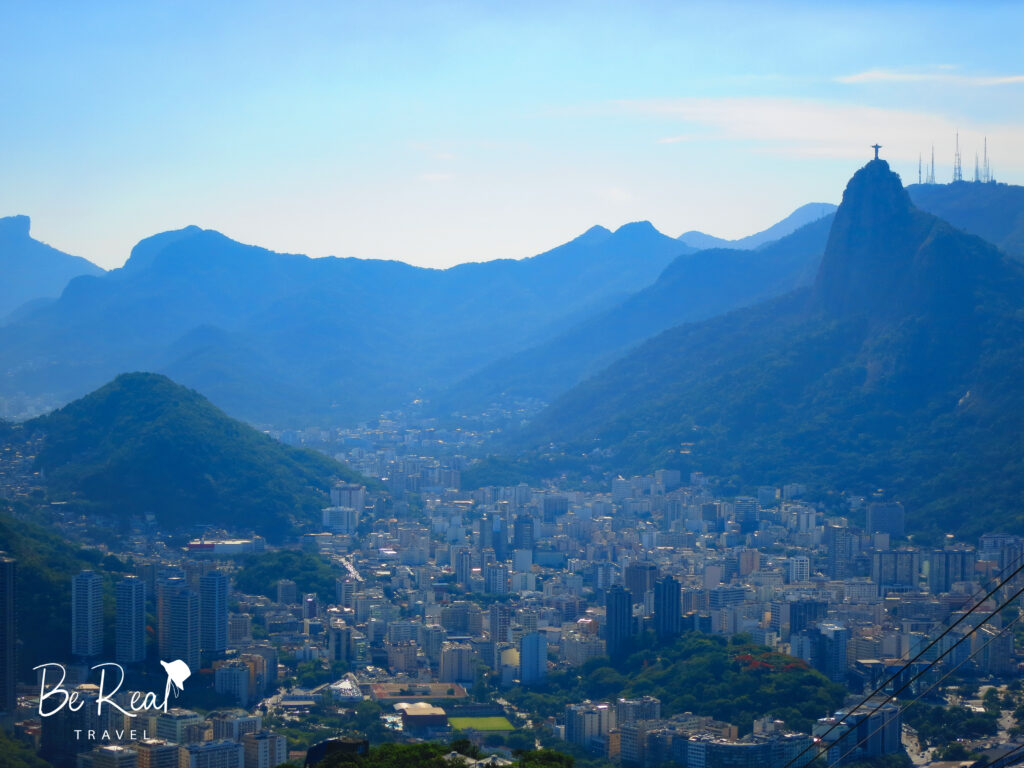
By the way, I’m all about that touristy “take a cable car into the sky” life. You can’t go wrong with a slow-moving, hanging-in-the-air capsule that takes you to a marvelously-elevated viewpoint. Here are my “cable cars into the sky” power rankings:
- Sugarloaf Cable Car (Rio de Janeiro) – those Cristo-accented views
- Mao Kong Gondola (Taipei) – that mountain tea life
- Sandia Peak Tramway (Albuquerque) – Breaking Bad desert vibes
- Table Mountain Aerial Cableway (Cape Town) – had to get my TIA reference in
- Palm Springs Aerial Tramway (Palm Springs) – nice forest hikes at the top (including woodpeckers that your mom hilariously imitated)
Finally, Rio de Janeiro’s redonkulous (apparently Eddie Murphy said this word in the 2001 movie Shrek, but I swear one of my grade school classmates regularly used this word back in like 1996) landscape views make it the perfect place to paraglide! In the ultimate “you only live once” moment (that music video reminds me of a certain famous trash compactor scene), your mom and I decided to paraglide over the outskirts of the city. Seven years prior, I paraglided in Cape Town, but paragliding is grandiose no matter how many times you do it. As we flew over mountains and beaches, I felt jealous that birds get to do this on the regular.
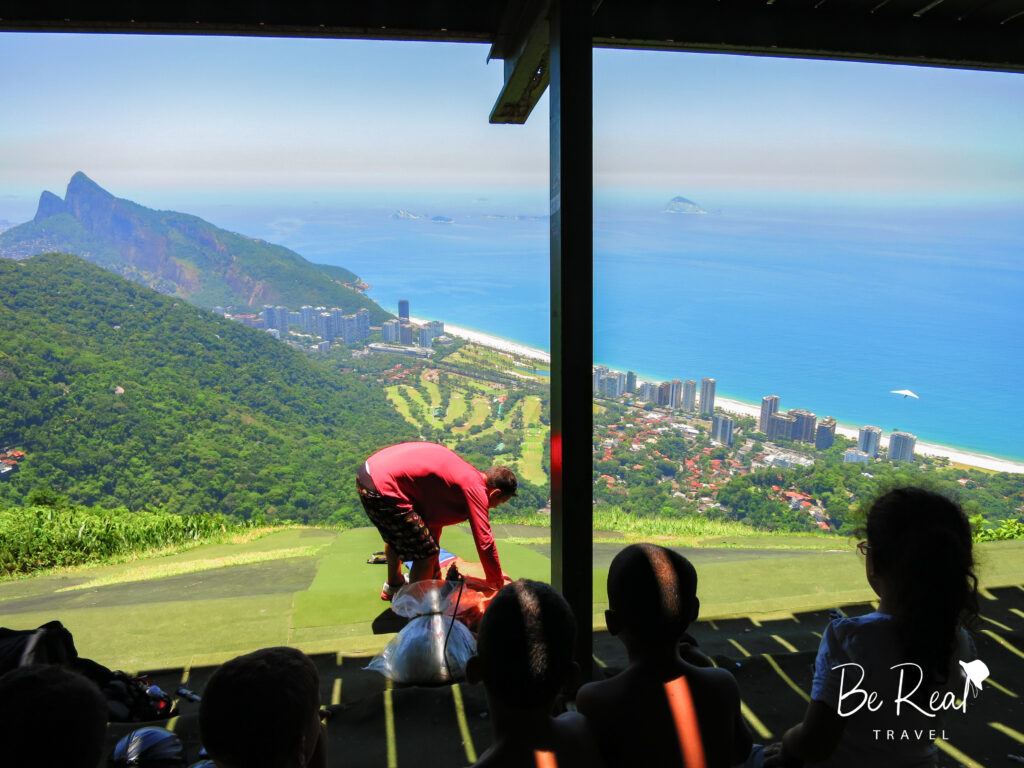
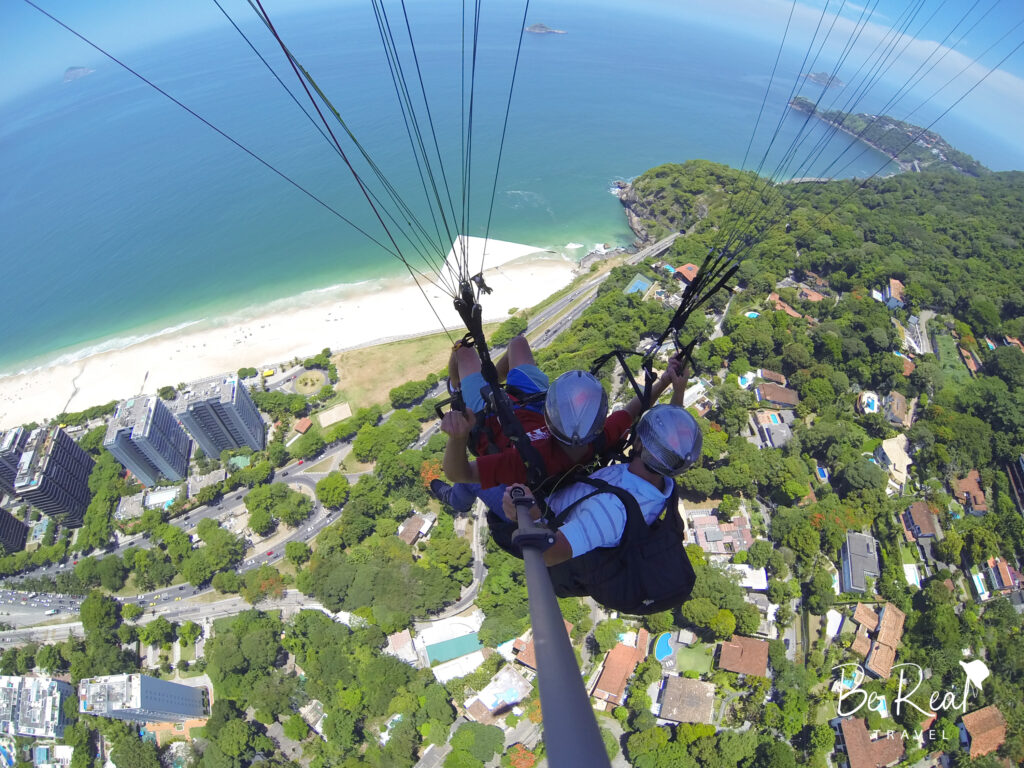

The beaches are a damn good time
In my previous letter, I raved that Dominica’s beaches are awesome because they’re uncrowded. Rio de Janeiro’s beaches are awesome for a very different reason. From boomboxes blasting samba music to hawkers selling knockoff Raybans to favela kids playing soccer to model-looking Cariocas (a nickname for Rio locals) rocking skimpy bathing suits, Rio de Janeiro’s beaches are a people watcher’s dream.
Rio de Janeiro’s proximity to the equator makes for the perfect beach weather. Even during the cool season (May to October), the average daily high temperature is 79°F. Just like in Hawaii, locals and visitors alike can swim in the ocean without a wetsuit or worry that their feet will feel like they have brain freeze (as a kid, this is how I often described how my feet felt while swimming at cold-ass northern California beaches, and yes – that’s my second “brain freeze” reference in three letters).
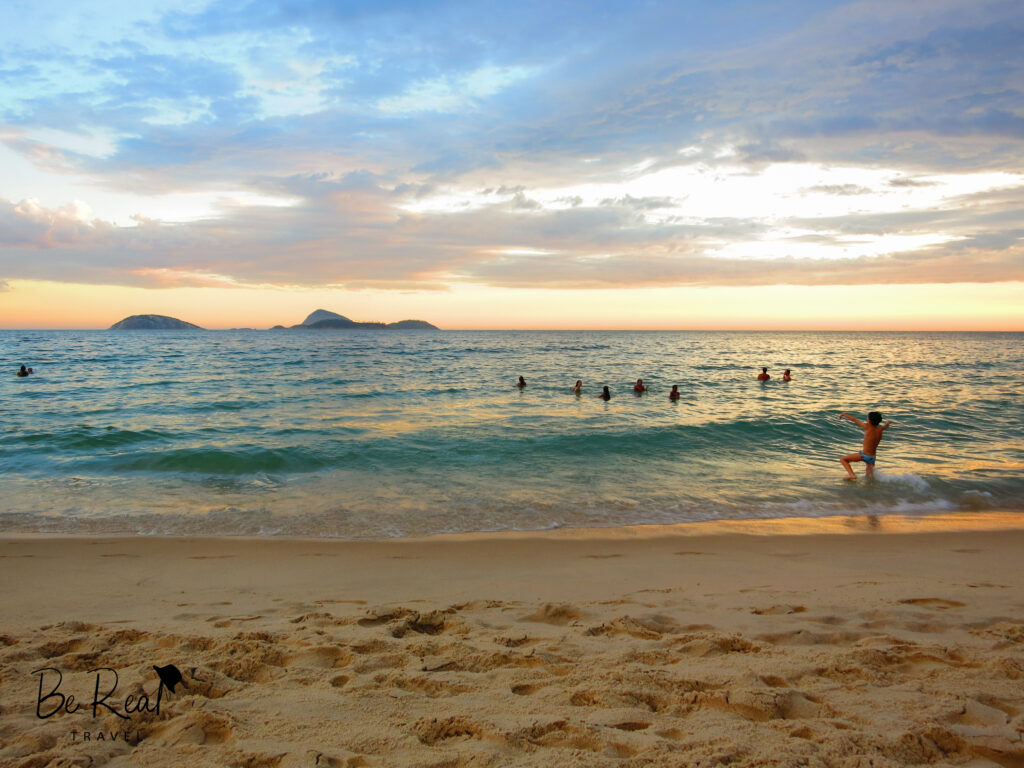
If you’re hungry, you can grab a low quality, unhealthy quick, tasty snack at a stand right off the beach. Alternatively, you can fuel up across the street at an open-aired restaurant featuring live music (I have a fond memory of dining at such a restaurant with your mom while a sultry-voiced Carioca strummed and sang to classic jams like Everybody Wants to Rule the World).

Rio de Janeiro’s two beaches, Copacabana and Ipanema, are so iconic that several establishments worldwide have been named after them. Martin Scorcese has used the Copacabana night club in New York in a trio of his films (e.g. Goodfellas, Raging Bull, The Irishman). Ipanema is referenced by the classic 1960s song “The Girl from Ipanema” (which at first I thought was a creepy song, but eventually realized that it’s the perfect song to chill to while sipping a sophisticated cocktail at a fancy hotel bar).
After a long day of working on my graduate school project, my afternoon routine consisted of going back to my hotel to throw on my swim trunks, walking to Copacabana beach and taking a nap on the sand, waking up slightly overheated, and running straight into the ocean for a refreshing swim. It was the good life.
Praia do Aproador (harpoon thrower beach) is a rocky area that sits at the intersection of Copacabana and Ipanema. Every summer evening, people gather on this small peninsula to watch the sunset. Your mom and I were delighted by one of the coolest sunset experiences we had ever been a part of. It was great to watch that golden-hour-lit ocean scene slowly turn into a Bob Ross painting.
What really set the experience apart was the sense of jovial community and childlike wonder that permeated across those rocks. Our fellow onlookers patiently waited (as if my references weren’t random enough, that 50 Cent and Eminem banger transports me back to a moment in 2003 when I was cruising downtown Waikiki during a family vacation and a car that drove by was bumping that song) as the sun dipped lower and lower toward the horizon, and burst into cheerful applause once the sun was gone.

We gringos need to lighten up and celebrate small wins with cheerful applause more often. Other experiences throughout my travels that shaped this opinion include when the Jaipur movie theater crowd cheered during action scenes, when African passengers on my flight to Ghana applauded when our plane landed safely, and when a Porteña woman applauded and smiled enthusiastically at the conclusion of the creation story attraction at the Tierra Santa religious theme park in Buenos Aires (yes, a religious theme park exists!) despite her and I being the only two people in the attraction’s auditorium (this last one really tugged at my heart strings; I will never forget how genuinely impressed she was and how amused and happy her candid reaction made me feel).
The snackage is on point
Like I mentioned earlier, Rio de Janeiro’s beaches are sporadically lined with food stands to satisfy beachgoer cravings. Need a quick snack but don’t want to lose your spot on the beach? Need to replenish electrolytes after a beachside run? Destroyed by waves and looking to drown your soreness away with fast food? These food stands have you covered!
Rio’s numerous snack shops dole out snacks so simple and tasty that even a picky child would enjoy them. The snack staples include pão de queijo (cheese-filled rolls), esfiha (pastry filled with meat and spices), coxinha (cornmeal balls filled with shredded chicken), and pastel de carne (deep-fried dough filled with meat). Like I found in Taipei, your taste buds can’t go wrong with a combination of carbs and meat (hold the veggies).
These shops are too small to have tables, but I had a great time just hanging out at the counter. There, I quickly dispatched my snacks and daydreamed amongst the hustle and bustle of Cariocas filtering in and out. It took serious discipline to resist ordering even more of the sinfully-enticing snacks taunting me from behind the display cases.
Many of these snack shops sell cups of açaí. This superfruit is one of my favorite “promoted as healthy but really not that healthy” sweet snacks in the world. According to this article from the The New Yorker, the açaí fruit grows across the Amazon River delta and is embraced due to its cholesterol-reducing fats and anti-aging antioxidants. When pureed, chilled, and dolled up with sugar and guarana, açaí is basically a dessert masquerading as a healthy treat. These days, the açaí bowl is fairly embedded in gringo superfood culture. I do miss being able to walk into any snack shop in Rio, pay a couple of bucks, and inhale an açaí cup.
Some of these snack shops serve up a random Asian dish or two. A few blocks away from my hotel, I found one snack shop that served up a mean yakisoba. On several evenings, I was too exhausted to go through the whole “research and go eat at a restaurant” excercise. Instead, I slammed that quick, tasty-ass yakisoba dish! My five-dollar yakisoba dinner was whipped up in a mere minutes by this Thai dude living above the snack shop. If the dude wasn’t down in the shop when I ordered, a worker would call him down. One time, I placed an order, then he rushed down and said that he had just woken from a nap. See, kid – It’s random crap like this that I love about travel. You bet your ass that I have a photo of me posing with that dude behind the grill!
A bunch of other good stuff
- I’m all about that caipirinha life – Yes, a cocktail gets its own bullet. Brazil’s national drink, the caipirinha, is among my favorite mixed drinks in the world. The caipirinha is made with cachaca (a liquor distilled from fermented sugarcane juice), sugar, and lime. This wonderful concoction tastes exactly what Rio de Janeiro would taste like: exotic and refreshingly sweet, but not overly fruity.
- The nightlife is world class – When it comes to partying, Cariocas go hard. Mix together a little samba, a lot of cachaca, and clubs that rage until the break of dawn and you have yourself a nightlife scene that puts the “our bars and clubs close at 2am” United States nightlife scene to shame.
- It’s a soccer utopia – I’m no soccer aficionado (except every four years during the World Cup when I controversially and un-patriotically root for Ghana and Argentina over the United States). I do know that Rio de Janeiro is a utopia for soccer lovers. From the Maracanã (Rio de Janeiro’s rich-with-history soccer stadium that played host to the 1950 and 2014 World Cups) to soccer-themed murals to frequent pickup games on the beach, soccer is an integral part of life in Rio de Janeiro. By the way, soccer balls are one of three images that you consistently point out in books that we read to you (the other two being rubber duckies and bees).


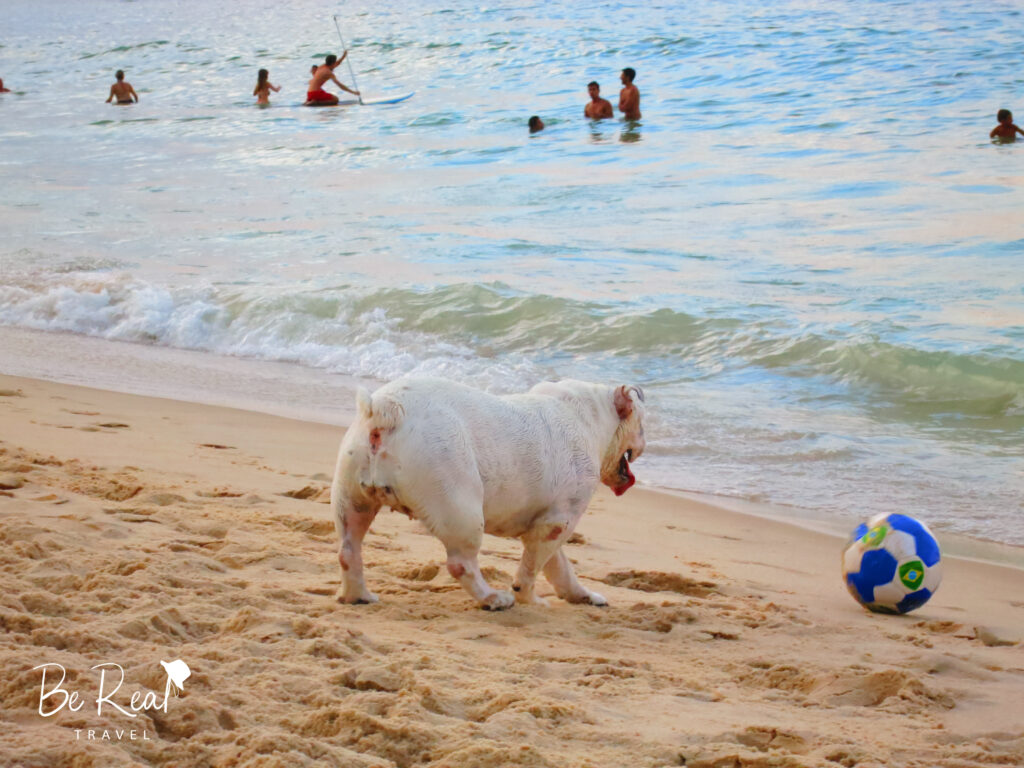
- It’s a fun place to run – I’ve never enjoyed running more than I did in Rio de Janeiro. A few months after our trip, your mom and I ran a San Diego half marathon. While in Rio, I started training. Turns out running is fun when you’re able to sightsee along a beautiful, happening beach while looking forward to paying a dollar for a street-side vendor to chop open a coconut with a machete and hook you up with that ice-cold coconut juice immediately after your run.
- The Escadaria Selarón is neat – Rio’s Escadaria Selarón consists of 2,000+ tiles collected from 60+ countries around the world. Each tile showcases a unique image, resulting in a mesmerizing “let’s just chill and admire art” experience.


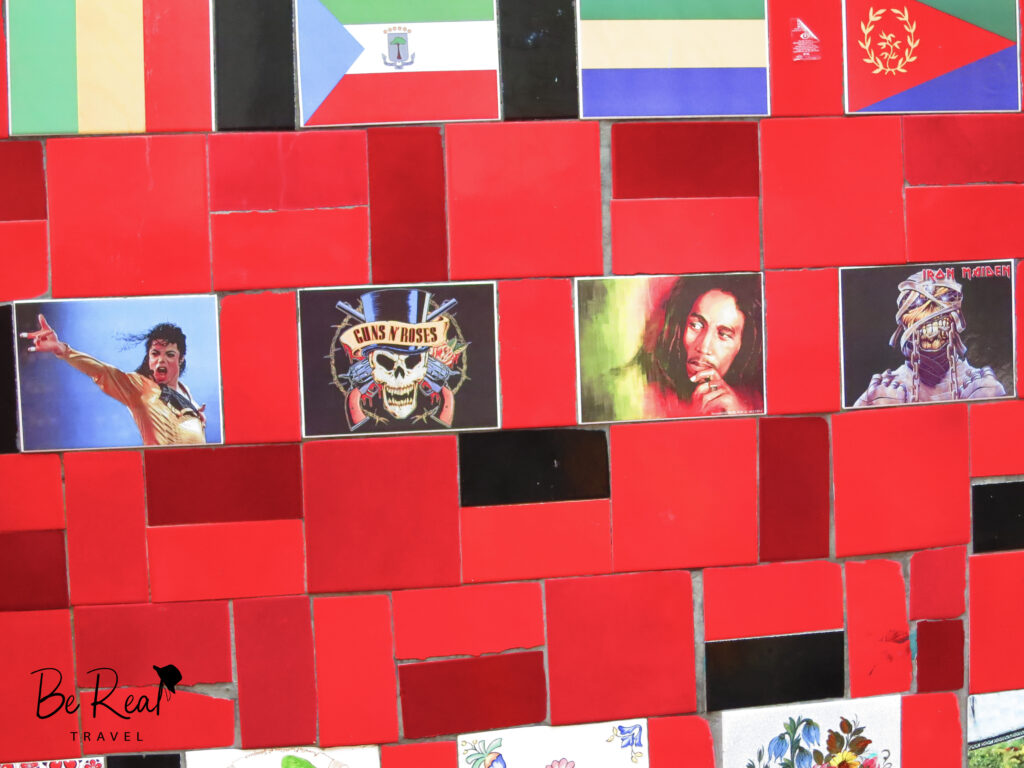
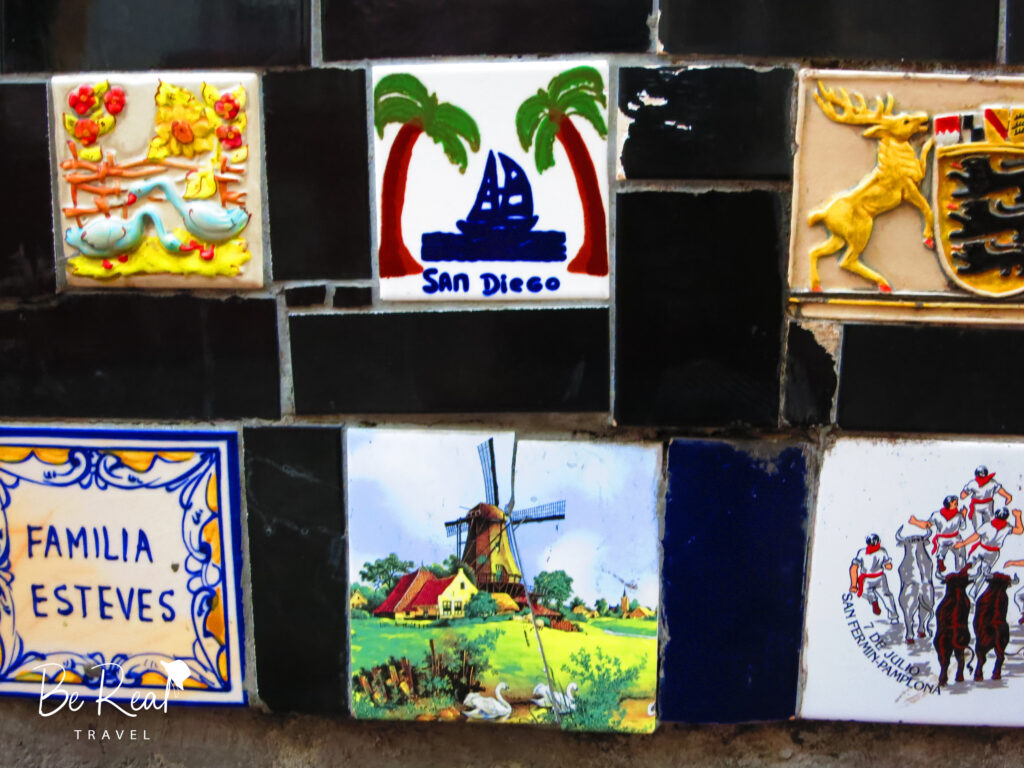
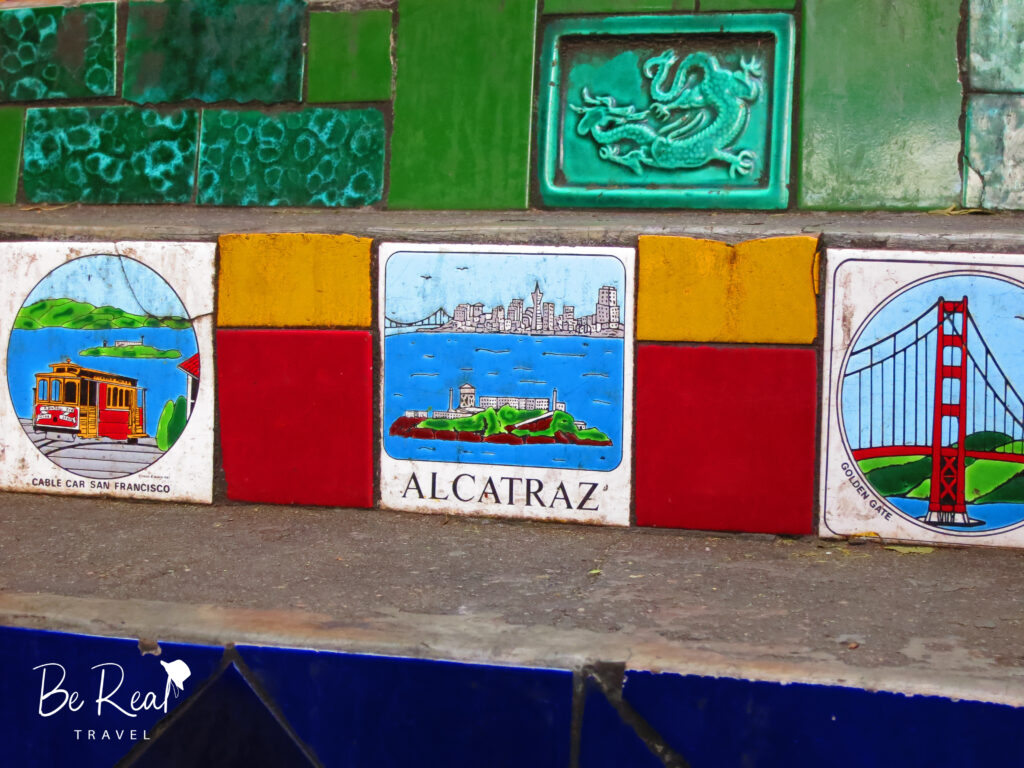
- It’s an excuse to check out other parts of Brazil – Brazil is huge. Your mom and I were lucky to get a taste of both that urban beach and that untamed rainforest life. Three years prior, we spent my birthday on the Argentina side of Iguazu Falls. I’m sure that the Brazil side is just as magnificent! I’ve heard good things about other spots in Brazil as well (e.g. Sao Paolo, various islands off of the coast). If you have the means to do so, plan those intra-country flights in and explore the different sides of Brazil!
THE BAD
Other than the snackage, the food is meh
Well kid, it was inevitable. For the first time, I have listed food under “The Bad”! I loved that Rio de Janeiro snack life, but I was not impressed with any of my actual meals.
I’m typically all about that churrascaria life. It’s tough to go wrong with a bunch of waiters walking around slicing bomb-ass, all-you-can-eat meat off of swords. The churrascarias that I ate at in Rio de Janeiro weren’t any better than those I’ve eaten elsewhere in the world (like Espetus in San Francisco aka the restaurant where I met your mom’s family for the first time, or Brasiliano in Kobe, Japan where we celebrated your mom’s birthday on a patio overlooking a sweet harbor view while being served by an African waiter that at one point, joked that we were eating monkey meat).
Feijoada is a beloved Brazilian specialty that consists of a variety of meats in slow-cooked black beans. The dish is often accompanied by white rice, kale, croutons, fried farofa, and orange pieces. I like every ingredient that I listed in the previous two sentences, but I wasn’t a fan of the dish! Feijoada is a boldly-flavored stew that felt like more of a hyped-up chore to eat than a pleasure. I actually really want to try feijoada again to determine whether my palate was off that day, or whether I ate a bad batch, or whether the cook messed it up. My mood wasn’t the culprit; I was actually flying high because I had just found out that I landed my post-graduate job in San Diego. Whatever the case, I’m looking forward to our next meeting, feijoada.
Another Brazilian specialty that disappointed me was moqueca, a seafood stew cooked in coconut milk. Based on this description, moqueca sounds bomb, right? Well, I found it quite bland and frankly unspectacular; if given the choice, I would confidently take any seafood dish from Dominica over moqueca.
I ate sandwiches in Rio de Janeiro – I wasn’t impressed (too much mediocre bread; give me the bomb-ass, topped-with-creative-sauces sandwiches from Cusco, Peru instead). I ate seafood in Rio de Janeiro – I wasn’t impressed (generic, uncreative flavors; give me a seafood dish from basically any other developing country instead). I ate steak in Rio de Janeiro – I wasn’t impressed (nowhere close to the mouth-watering divineness that Argentina offers).
So many other Latin American countries seem to dominate Brazil when it comes to food tastiness (e.g. Argentina, Uruguay, Nicaragua, Mexico). I guess Brazil is like, “Yo, we have really nice beaches and an abundance of cachaca; we can afford to have mediocre food.” (that, or Brazilian food just isn’t my thing, which is more likely the case).
The city isn’t safe
I felt pretty safe in Rio de Janeiro. Then again, I didn’t venture into the especially-crime-ridden favelas (Rio de Janeiro’s low-income slum neighborhoods). According to the U.S. Department of State’s Overseas Security Advisory Council’s (OSAC) Brazil 2019 Crime & Safety Report: Rio de Janeiro, visitors should be vigilant no matter where they are in the city:
“There is serious risk from crime in Rio de Janeiro. Violent crimes such as murder, armed robbery, carjacking, assault, and kidnapping are a frequent occurrence. Opportunistic street crime such as pickpocketing, purse snatching, and smash-and-grab theft from vehicles and storefronts is a constant concern. These acts take place in all areas of the city at any time throughout the year.”
As of summer 2020, Numbeo’s crime index for Rio de Janeiro is consistent with OSAC’s report. The report cites a rating of “Very High” for criteria such as “Level of Crime”, “Crime increasing in the past 3 years”, and “Worries being mugged or robbed.”
Here are two articles (both written in 2019) that seemingly tell very different stories when it comes to the murder rate trajectory in Rio de Janeiro: “Brazil’s Murder Rate Finally Fell – and by a lot” and “Why Rio is Brazil’s New Murder Capital”. Either way, tough look for Rio de Janeiro.
I have friends that ventured into the favelas and said that they felt safe and had great experiences. For me, there are plenty of kickass things to do elsewhere to warrant staying the F out of there. Venture into the favelas at your own risk, kid!

It’s a challenge to communicate if you don’t speak Portuguese
Portuguese is the official language of Brazil, but that initially didn’t faze me given my conversational Spanish-speaking skills. Turns out that I should’ve been fazed (does the expression work like that?). While I didn’t struggle to communicate with Cariocas quite as much as I did with locals in Taipei, my Spanish skills didn’t take me nearly as far as I hoped. I have painful memories of arduously trying to find a place to eat dinner on New Year’s Eve and becoming extremely frustrated because of the language barrier.

Police brutality is a problem there too
This isn’t necessarily a reason not to visit Rio de Janeiro, but given that the United States has recently been aflame with protests against police brutality (spurred in large part by an incident in which a white cop murdered a black dude by kneeling on the back of his neck, while knowingly being filmed, for 8:46), I figured that I would dig in a bit on how things are looking on the police brutality front in Rio de Janeiro.
Rio de Janeiro’s population is made up largely of people of European descent (as Brazil was once a Portuguese colony, the city has more people of Portuguese descent than Portugal’s capital, Lisbon) and of African descent (as more than four million African slaves arrived to Brazil between the 16th and 19th centuries, the country has the most people of African descent than any country outside of Africa). As is often always the case, anytime you have a bunch of white people living near a bunch of black people, crappy things like bigotry, discrimination, and police brutality ruin any semblance of hope for a society rooted in harmony and racial equality (though I am hopeful that things will improve throughout your lifetime!). But how bad is it in Rio de Janeiro?
Well, a headline and a quote from this BBC News article tell you just about all that you need to know about how things are going in Rio de Janeiro: “Rio violence: Police killings reach record high in 2019” and “Most of the victims of police raids are young black men who live in poor neighborhoods.”
In 2019 (per the BBC article above), police in Rio de Janeiro killed about five people per day. For comparison’s sake, according to this Washington Post tracker, in 2019, police in the United States killed almost three people per day. This is a drastic difference considering that Rio de Janeiro’s population is just a fraction of that of the United States (13M vs. 331M respectively).
In Rio de Janeiro, proponents of President Jair Bolsonaro’s aggressive crackdown on suspected criminals will point out that the recent increase in police killings has resulted in the decrease of rampant crime carried out mostly by young black men in the favelas. Either way, through skimming several articles on the topic of police brutality in Rio de Janeiro, I learned that the same “white cops unjustly killing black people in the name of fear and/or public safety” crap that happens in the United States happens in Rio de Janeiro (and at a much higher rate!).
According to this Financial Times article, there are striking similarities between Brazil and the United States when it comes to race relations: both have a history of slavery and police brutality against black people; both have recently elected openly-racist presidents; and over the past few months, both have erupted into widespread #blacklivesmatter protests.
Kid, my only request of you on the topic of race is this: don’t just tolerate diversity; seek it out and embrace it. From my experience, life is a lot more stimulating / rewarding / fun when you get to know people that come from backgrounds that are vastly different from yours. When it comes to racism (and really, life in general), I hope that more often than not, you’re not the bully, you’re not the one being bullied, but you’re the one that steps in to stand up to the bully (I heard this characterization on a podcast years ago and will never forget it).
THE BOTTOM LINE
I love Rio de Janeiro. At the same time, I could see why not everyone may feel the same way. You would probably think Rio de Janeiro is an overrated travel destination if you:
- Prefer peace and quiet
- Catastrophize about being mugged
- Melt in hot weather
- Don’t speak Portuguese and stress out when you can’t easily communicate with locals
- Are afraid of the ocean
- Are disgusted by skimpy swimsuits and scantily-clad people
I love Rio de Janeiro because of the lively beaches, killer landscape views, fresh coconut juice and caipirinha life, and superb snackage options. It’s one of the most fun cities that I’ve visited and I can’t wait to hear crazy stories about your inevitable trip to Brazil’s metropolis by the sea.
Love,
Dad
P.S. I wrote this letter during the final month of your first year! As I write this sentence, you’re passed out with your body in the shape of the letter “L”. Tonight was the first time that I ever put you to sleep without rocking you. I was sweaty from a workout, so I tired you out by staging an intricate, lengthy fight scene with three of your stuffed animals. I then laid you face up in your crib, rubbed your belly, then exited the room and watched on the monitor as you did a 360-degree turn to find your sweet spot before nodding off to dreamland.
P.P.S. Weeks after I wrote the P.S. tidbit above, you turned one and smashed a cake! It was priceless.
